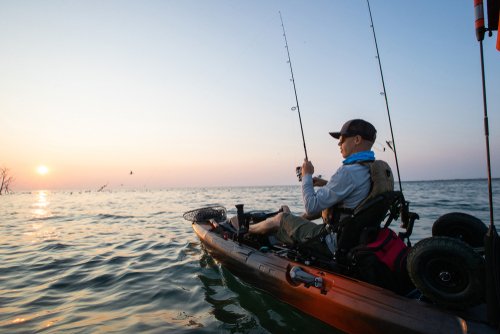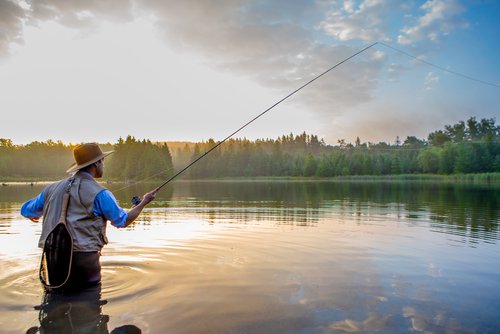Regarding bass fishing gear, the fishing rod is your faithful companion on the water. Anglers choose three main types of fishing rods: spinning, casting, and fly rods. Each serves a purpose and offers unique advantages.

Spinning rods are the most popular choice for bass anglers due to their versatility. They have a reel seat below the rod and guides facing downward, making them ideal for casting lighter lures and using lighter lines.
Spinning rods are also great for beginners as they are easier to handle and provide better control. Casting rods, on the other hand, excel at handling heavy lures and lines.
They have a reel seat positioned on top of the rod with guides facing upward, allowing for accurate casts over long distances. A casting rod is your go-to option when targeting bigger bass or employing techniques like flipping or pitching into heavy cover.
Fly rods are specifically designed for fly fishing techniques where artificial flies are used to attract fish. Although not as commonly used in bass fishing as spinning or casting rods, fly fishing enthusiasts often succeed with certain patterns designed to imitate insects or small baitfish.
Choosing the appropriate rod length, power, and action
Selecting the right rod length, power (also known as weight), and action is crucial for maximizing your success when targeting bass. The ideal length of a bass fishing rod typically falls between 6 and 7 feet but can vary depending on personal preference and specific angling techniques.
A shorter rod offers better accuracy when casting in tight spaces, such as under docks or around vegetation, while sacrificing some casting distance. Conversely, longer rods provide increased casting distance but can be less maneuverable in confined areas.
The power of a rod refers to its ability to handle different lure weights and line strengths. A medium-power rod is a popular choice for bass fishing as it offers versatility for a wide range of lure sizes.
However, anglers may opt for medium-light or medium-heavy power rods depending on the target species and fishing conditions. Action refers to how much the rod bends under pressure.
Fast-action rods bend primarily at the tip, providing increased sensitivity and responsiveness, making them ideal for techniques requiring precise hooksets. Moderate-action rods bend throughout their length, offering more forgiveness when fighting larger fish or using treble-hooked lures.
Understanding reel types
Reels are equally important in bass fishing gear as they are responsible for line retrieval and drag control. Three main types of reels are commonly used in bass fishing: spin cast, spinning (also known as open-face), and baitcasting reels. Spincast reels are often the choice of beginners due to their simple design and ease of use.
They feature a closed face with a push-button release mechanism that makes casting straightforward. Spincast reels work well with lighter lines but may lack the strength for heavier lures or bigger fish.
Bass anglers widely favor spinning reels due to their versatility and ease of casting. With an open-face design, these reels offer better line control during casts and can handle varying lure weights effectively.
Spinning reels also handle lighter lines, which is advantageous when targeting finicky bass in clear waters. Baitcasting reels provide unmatched power for battling big bass and handling heavy cover situations.
These reels sit atop the rod’s reel seat and are controlled by your thumb’s pressure on the spool during casting to prevent backlash tangles. Baitcasters offer exceptional accuracy and control, making them a top choice for experienced anglers who require precision in their presentations.
Factors to consider when selecting a reel for bass fishing
Several factors come into play when deciding on the right reel for your bass fishing adventures. First and foremost is the line capacity, which should match the line strength you intend to use.
Ensure the reel accommodates enough lines to handle long casts and any potential fights with trophy-sized bass. Another critical consideration is the gear ratio, which determines how quickly the line is retrieved with each turn of the reel’s handle.
A higher gear ratio provides faster retrieval speeds, ideal for techniques that require quick bait presentation or covering large areas. Lower gear ratios offer increased torque and excel at handling heavier baits or when slow presentations are necessary.
The reel’s drag system is paramount when battling strong-willed bass. A smooth and reliable drag allows fish to run while providing enough resistance to tire them out over time.
Look for reels with well-engineered drag systems that maintain consistent pressure without sudden jerks or slips. Ergonomics also play a role in selecting a reel that suits your preferences.
Consider factors such as overall weight, handle design (left or right-handed), and comfort during extended periods of casting and retrieving. By carefully considering these factors and matching your rod and reel choices to your fishing techniques and preferences, you’ll be equipped with a formidable combination that ensures an enjoyable bass fishing experience.
Lines and Leaders: Connecting Anglers to Bass
Types of fishing lines (monofilament, fluorocarbon, braided)
Several options are available when choosing the right fishing line for bass fishing. Monofilament lines are a popular choice due to their versatility and affordability. They have a lot of stretch, which can be advantageous when fighting powerful bass.
Fluorocarbon lines, on the other hand, are known for their invisibility underwater. This makes them an excellent choice in clear water conditions where bass may be more cautious.
Braided lines offer exceptional strength and sensitivity. They have minimal stretch, allowing anglers to feel even the slightest nibble from a bass.
Strength and diameter considerations for different line types
When selecting a fishing line for bass fishing, strength and diameter are crucial in determining its effectiveness. The strength of the line is typically indicated by its pound test rating.
For instance, you might come across lines with pound test ratings like 10lb or 20lb. Stronger lines are recommended when targeting larger bass or fishing in dense cover where abrasion resistance is essential.
The diameter of the line is also important because it affects its visibility underwater and ability to cast smoothly through the air. Thinner diameter lines tend to be less visible but may sacrifice some strength compared to thicker ones.
Benefits of using leaders in bass fishing scenarios:
In many cases, using leaders can significantly enhance your success in bass fishing scenarios. A leader is a separate length of line that’s attached between your mainline and lure or bait.
The primary benefit of using leaders is providing extra protection against sharp teeth or abrasive cover that could otherwise weaken or damage your mainline directly during battles with bass. Depending on the situation, leaders can be made of materials like fluorocarbon or wire.
Fluorocarbon leaders are virtually invisible underwater, which can help entice wary bass into biting. On the other hand, wire leaders are primarily used to prevent toothy predators such as pike or musky from biting through the line.
Moreover, leaders also offer versatility in changing lures quickly without having to re-tie your mainline repeatedly. Attaching different lures or baits directly to the leader allows you to experiment with various presentations and increases your chances of enticing bass into striking.
Lures and Baits: Tempting Bass into Bites
Overview of different lure categories (crankbaits, jigs, soft plastics)
When it comes to bass fishing, having a diverse collection of lures is essential to entice those cunning bass into biting. Some of the most effective lure categories for bass fishing include crankbaits, jigs, and soft plastics. Each type has unique characteristics that can attract the attention of these elusive fish.
Crankbaits
Crankbaits are popular among bass anglers due to their versatility. These lures mimic the movements and appearance of real baitfish, making them irresistible to bass. One important consideration when selecting crankbaits is their diving depth and lip design.
Different crankbaits have varying diving depths, ranging from shallow runners working well in shallower waters to deep-diving models targeting fish in deeper areas. The lip design also influences the lure’s action in the water, with wider lips creating more wobbling motions and narrower lips producing tighter wiggles.
Jigs
Jigs are highly effective for enticing reluctant bass into biting. Featuring a weighted head and a skirt made from materials like silicone or living rubber, jigs imitate prey such as crawfish or baitfish.
What makes jigs so versatile is their ability to be fished at different depths and structures. Additionally, jig heads come in various shapes, such as football heads or flipping heads, each designed for specific fishing techniques or environments.
Soft plastics
Soft plastic baits have gained popularity due to their lifelike appearance and natural movements underwater. Worms and creature baits are two common types within this category that consistently produce great results when targeting bass.
Worms often imitate natural prey like earthworms or aquatic insects, while creature baits replicate small aquatic creatures like crayfish or frogs. Soft plastics allow anglers to experiment with different rigging options, such as Texas or Carolina rigs, depending on the fishing conditions and bottom structure.
Color selection strategies based on water conditions and fish behavior
Selecting the right color for your lure is essential for maximizing its effectiveness. Understanding how water conditions and fish behavior impact color preferences will greatly increase your chances of landing that trophy bass. When fishing in clear water, it’s best to opt for natural colors that closely resemble the baitfish or prey species in the area.
Shades of green, brown, or silver are commonly effective choices. In murky or stained water, brighter colors like chartreuse or fluorescent hues tend to stand out better and grab a bass’s attention.
Fish behavior can also influence color preference. On bright sunny days, when bass are often more active near the surface, using lures with lighter colors can be advantageous as they appear more visible against the sunlight.
Conversely, darker-colored lures can create better contrast and provoke strikes from feeding bass on overcast days or during low-light conditions. Experimentation is key when it comes to color selection.
Don’t hesitate to try different colors until you find one that triggers a reaction from that elusive bass. Remember that changing light conditions throughout the day may require adjustment in lure color choice to maintain productivity.
Successful bass fishing involves understanding lure categories and making informed decisions based on water conditions and fish behavior. By equipping yourself with an assortment of crankbaits, jigs, and soft plastics while considering the appropriate colors for each situation, you’ll be well-prepared to tempt those cunning bass into biting!
Terminal Tackle: Essential Accessories for Bass Anglers
Hooks: Styles and Sizes for Different Baits
Regarding hooks in bass fishing, anglers have two primary options: offset and straight shank. Offset hooks are widely used due to their ability to increase hook-up ratios by providing better penetration. The offset design allows the hook’s point slightly bent away from the shank, ensuring a higher chance of hooking into the fish’s mouth.
On the other hand, straight shank hooks provide excellent holding power once a bass is hooked, making them ideal for lures like worms or soft plastics. Selecting the right hook size is crucial as it directly affects bait presentation and hooking efficiency.
For smaller baits or finesse techniques, such as drop shotting or wacky rigging, using sizes between #1 and #4 would be appropriate. When targeting larger bass with bigger baits like swimbaits or creature baits, opting for sizes ranging from #3/0 to #5/0 is more suitable.
Weights: Understanding Bullet Weights vs Tungsten Weights
In bass fishing, weights determine how your bait behaves underwater. Bullet weights are traditionally made of lead and offer affordability and versatility. They are typically shaped like cylinders with holes running through the center for easy threading onto your line.
These weights provide enough mass to help lures reach desired depths quickly. Tungsten weights have gained popularity among seasoned anglers due to their unique advantages over traditional lead weights.
Tungsten has a denser composition than lead, allowing for smaller and more discreet profiles while maintaining weight. This characteristic makes tungsten ideal when finesse techniques demand subtle presentations in heavily pressured waters.
Moreover, tungsten weights transmit vibrations better than lead counterparts, providing enhanced sensitivity to detect even the slightest bites. They come in various shapes and sizes, including bullet, cylindrical, and flipping weights, allowing anglers to adapt to specific fishing conditions and techniques.
Swivels and Snaps: Their Role in Preventing Line Twists
Swivels and snaps are indispensable terminal tackle components that help prevent line twists while offering convenient lure changes. Swivels act as connectors between the mainline and leader or lure, allowing smooth rotation without tangling or kinking the line.
They come in different sizes and strengths to match the fishing situation. Snaps are quick-release attachments that provide easy bait or lure changes without retying knots.
They offer versatility when experimenting with different presentations or swapping out lures to adapt to changing conditions on the water. Snap sizes should be chosen based on the weight of your lure or bait for a secure connection.
By incorporating swivels and snaps into your bass fishing gear setup, you minimize line twist issues caused by spinning lures or aggressive fish movements. This will ensure a hassle-free angling experience while maintaining optimal performance throughout your fishing outings.
Conclusion
As you delve into the world of bass fishing gear, remember that having a well-rounded selection of terminal tackle is essential for success on the water. Choosing hooks according to their style and size helps maximize hook-up ratios based on different bait types, ensuring a higher chance of landing that prized bass.
Understanding the benefits of tungsten weights allows for versatile presentations with enhanced sensitivity, while swivels and snaps reduce line twists and facilitate quick lure changes. Equipping yourself with these essential accessories sets you up for success and adds convenience to your fishing experience.
Combining knowledge about terminal tackle with skillful angling techniques, you embark on an exciting journey where every cast promises to reel in that trophy-sized bass you’ve been dreaming about. Happy fishing!





